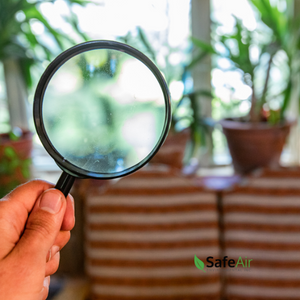Are There Drawbacks to Indoor Air Quality Testing?
Posted in Air Quality, on January 31, 2023
Are there pros and cons to indoor air quality testing? After performing hundreds (if not thousands!) of air quality inspections across the GTA, the SafeAir team has learned a thing or two about indoor air quality, comfort, and safety. If you’re thinking of scheduling mold inspection, radon testing, or general air quality tests, here’s what we think you should keep on your radar.
What Indoor Contaminants Do People Test For?
 First, let’s look at some of the common air quality contaminants that affect homes across the GTA. These include:
First, let’s look at some of the common air quality contaminants that affect homes across the GTA. These include:
- Pollen
- VOCs
- Particulate matter
- Formaldehyde
- Carbon monoxide
- Radon gas
- Mold spores
In the pro column, it’s easy to see how identifying and reducing exposure to these contaminants is a positive thing. From increased asthma attacks to general malaise to long-term adverse health effects, these indoor air quality pollutants impact your health and wellness daily.
On the other hand, not all indoor air quality tests are created equal —choosing the wrong test, working with a general contractor instead of a specialist, and many other things can quickly make your testing useless or irrelevant.
How Does DIY Air Testing Work?
One of the biggest problems in indoor air quality testing is that there are now many DIY tests on the market. At SafeAir, we prefer professional testing for the following reasons:
- DIY tests are notoriously inaccurate: For example, when it comes to radon gas testing, careful, informed placement of the testing device is essential for an accurate reading. The ideal location may not be apparent or even logical to the average homeowner and can lead to inaccurate results.
- DIY tests lack specificity: Another issue with DIY tests is the lack of specificity needed to identify what’s happening in your home because most DIY mold tests give you a yes or no answer. In contrast, a professional mold inspection can identify the type of mold, pinpoint the location of single or multiple infestations, and help discover the cause of the problem.
- DIY tests lack context: One of the essential benefits of having professional air quality testing is that we can apply discretion and context to our work, considering various elements that may affect today’s reading — but not next month’s. DIY tests also tend to focus on single rooms or areas of your home, whereas, at SafeAir, we know how external factors, like tree growth or landscape, can affect the interior.
The Dangers of Inaccurate Results
When you have an inaccurate or unspecific test result, there are a few different issues than can arise. First, your health will suffer in the short and long term. The second is that you could be facing thousands of dollars in repair or remediation bills if the DIY test, for example, misses a mold infestation because of a user or test error. And lastly? We think your sense of safety and comfort at home is critical to overall health and wellness, and inaccurate results can severely shake your confidence. The best way to mitigate indoor air quality testing mistakes is to skip the DIY at-home tests and contact the professionals instead.
SafeAir is the GTA’s most trusted expert team for accurate, trustworthy indoor air quality testing. To tell us more about your air quality concerns, talk to an indoor air quality professional,

